An Illustrator's View by Emmeline Pidgen (guest blogger)
I have to say, I'm beyond thankful that I'm one of those lucky ducks who get to do what they love everyday and earn a living from it.
 But I don't think I could count the number of times I've had people turn glaze-eyed with jealousy or scoff at the 'triviality' of my job when I tell them I'm a freelance illustrator. “Oh so you draw pictures all day!?” they say, well, I'm not complaining – but I'll tell you this, it isn't half as easy as it sounds.
But I don't think I could count the number of times I've had people turn glaze-eyed with jealousy or scoff at the 'triviality' of my job when I tell them I'm a freelance illustrator. “Oh so you draw pictures all day!?” they say, well, I'm not complaining – but I'll tell you this, it isn't half as easy as it sounds. To mold yourself a successful career in the over-saturated creative industries, and in particular the children's book illustration field, you have the guts to jump into it head-first, with a battle cry of determination and with every ounce of gusto in your body – not to be too dramatic.
Looking through the piles and piles of picture books in my flat, I find it hard not to think technically about how the illustrators have created each page; the character designs, the storyboarding, the flow and composition from spread to spread, the weeks and weeks of editing. But don't worry, I'm not too jaded, I can still sit down and thoroughly enjoy reading them when I want to.
I've seen a number of posts here detailing the author or publisher's experiences of picture book creation, and I wanted to let you in on the perspective of the illustrator.
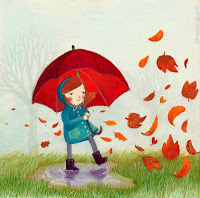
Relatively speaking, I've not been in the game long. I graduated from the BA(Hons) illustration course at University College Falmouth in 2010 and dived straight into self-employment. Things inevitably started fairly slowly, but now I'm here – two years on – and I'm about to start working on my fifth published children's book, and I've got a number of great clients, collaborations and awards under my belt - not bad for a fledgeling I'd say.
But behind the scenes there's a storm of stress, screen-wearied eyes and pencil cramped hands.
There aren't many moments more exciting than getting that call or email sparkling with the news of a new book commission, you might think it's silly, but it gives me that tingly feeling in my tummy every time. So, you've got the text, you've got the contract and you've got the guidelines. “Go!” shouts the publisher, “Go now and create beautiful worlds for our eyes!”...and so you do. In my experience the projects usually start with a cup of tea, a thorough read through of the text, some notes and a few rough sketches detailing the images that first come to mind. You discuss your ideas with the publishers and develop some initial character designs.

For me, the next stage is a series of loose thumbnails outlining a basic idea and composition for each page. Usually, at this stage these are more or less indecipherable to anyone but myself, so I rework them bit by bit into something comprehensible for the publishers to make comments on.
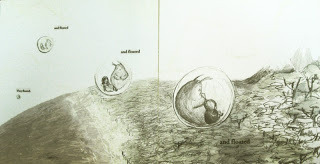
Sometimes it can be a little frustrating having so much free scope with the visuals in a book, just that it means that there's a lot of back and forth with the publishers deciding what they like or dislike in the storyboards and even through to the final artworks. As Malachy has said in a previous post, it's not often that the author and illustrator have much contact – however I remember clearly that for one of my books the author implicitly requested that I delete the knickers on the washing line!
It's a joy to be able to interpret the text however your imagination molds it, it's exciting, but as opposed to the visuals on each page being dictated - there's more chance it's completely off the mark for the publishers or author.
Changes to the illustrations are pretty much inevitable, and can drag on for weeks. It does feel very disheartening when a page you've worked really hard on is completely scrapped – or an idea you loved just isn't working, but it's all part of the bigger picture and in my experience, it's always made for a better book at the end.
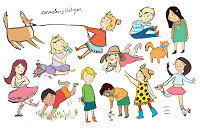
There are a lot of subtle tricks and techniques that go into creating illustrations for a really well formed book. It's much more than slapping a picture on every page. One of the main things I consider is 'pace and flow' which is basically the visual rhythm and movement throughout the book. A good illustrator can slow the visuals down and draw the reader in with a full bleed, detailed double page spread when the text slows, or speed things up with a heavily directed whoosh, whoosh, whoosh of spot illustrations when the story's fast paced.
Colour is definitely one of the most important factors, at least in my work. It's so connected to our basic emotions and signifies meaning on both conscious and subconscious levels. It's natural for us to feel that an illustration of a big, shadowy coloured creature would be more frightening than a powder pink one. Of course shape factors in to this a lot, spikey vs soft and all that, but it's the visual language of colour that can dramatically change the feel of a page.
Playing with scale, shape and variety of the 'camera angle' keeps the pages interesting and the reader engaged, whilst little details mean the reader can spot something new each time they pick up the book. It's mostly a case of thinking back to when you were a child, and what you would enjoy seeing.
For me, the final artwork stage takes the most time. I know of a lot of illustrators who tend to spend longer on the sketches, making sure everything is precise and perfect in pencil – which is obviously very useful for the publisher to get a really clear idea of what to expect at artwork stage. With my work I don't incorporate the pencil sketches into the finals, and so if it fits with the project and the publishers are happy I prefer to fully refine everything whilst creating the colour pieces. For my first book 'The Flyaway Blanket' I worked in gouache paint, which although lovely, was laborious and complicated to change later on (I did do very detailed sketches for this one!).
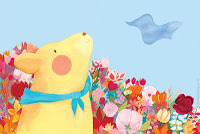
More recently I've tended to work with ink line and digital, which is faster and much easier to make changes to – which is appropriate for the tight deadlines and quick turnarounds I've been facing of late.
Although these days a lot of my work is digital, I always try to incorporate scanned painted elements or textures to give the illustrations some weight and a more organic feel. Within the past year I've learnt a wealth of new techniques to get my illustration style looking the way I want it to look, as fast as possible, but without compromising the quality. I often think that my entire career is just my hands trying to catch up with my imagination.
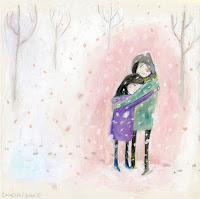
With picture books, I like to consider the commission not as a simple job, but as a world you're creating alongside the author and the publishers. A world to fuel children's imaginations and strike a nostalgic chord of adventure in the Mums and Dads snuggled reading the book to their children.Anything's possible between the covers of a book and it's the illustrator's duty not just to visually replicate what the words say, or to replace the images in the reader's imagination; but to enhance it with a vivid snapshot, a window into that world you've all created together.
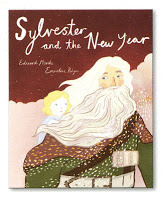
www.emmelineillustration.com@emmeline...
Published on August 26, 2012 23:43
No comments have been added yet.



